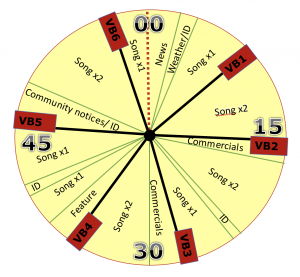Tip of the week 2017-04-24: The value of the clock

Guest column from Lisa Balzer.
Recently I was working with a group of online radio producers who had been creating content for several years. They had never received formal training, yet despite this they were doing a formidable job with writing and producing topical programs of varying lengths.
At one point, I asked whether they had a clock template for each program. Initially they said “yes”, and one lady hurried off to find a printed sample. What they showed me was a table of times, topics, and lengths for each program for the week. This was the extent of their template. I knew we had a great opportunity to introduce a tool which would provide both clarity and flexibility to their creative process – a program clock.
What is a program clock? Basically, it’s a very simple, illustrative look at your program as if it were a time-piece on the wall. It highlights the major themes and elements which will occur, and the approximate times they should happen, like the example shown.
The clock does not need great detail – but it should show the blocks of time for news, music, station IDs, features, and commercial breaks. Voice breaks, denoted as VB in the example, can be highlighted as well.
Once you begin to visualize your program in this way, it is easy to memorize what should happen at approximately what time. If something unusual comes up which needs to go to air (for example, an on-location announcement or a visiting musician stops in to send greetings), you can easily make a decision on the best place to insert the item. Somewhere which makes sense and does not interrupt the flow of the program. Also, the clock helps you to balance the talk, music, features, and station IDs throughout the hour. Finally, if the regular program host is sick or away, the clock helps a stand-in announcer to quickly become familiar with the format of the program and where the major features are.
So how did my group of online radio producers feel about the clock? Well, several said it was the most valuable thing they learned in our three-day workshop, and would be a huge help in their program planning going forward. Although they had been working for years without it, this simple tool provided the picture of clarity and flexibility they had been missing.
Happy broadcasting!
Lisa Balzer
: Blogs